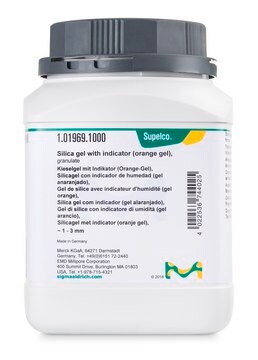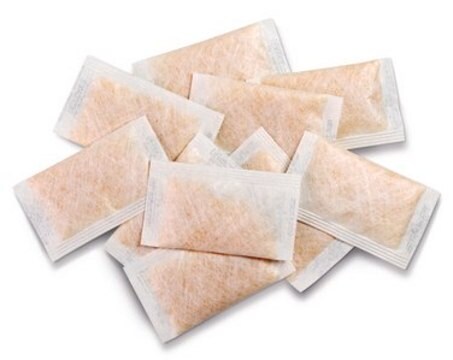94098
Drying pearls orange
Sinônimo(s):
Aluminum silicate, Silica gel orange
Faça loginpara ver os preços organizacionais e de contrato
About This Item
Produtos recomendados
descrição
heavy metal free
forma
beads
capacidade
>30 % absorption capacity (water)(at 80% rel. humidity, 25°C)
Descrição geral
Drying pearls Orange (Silica gel orange), commonly used as a drying agent in laboratories, is suitable for drying all gases and solids. It is used in desiccators, drying towers, and absorption tubes. Silica gel orange provides longer storage conditions due to its large surface area which enables high absorption capacity. It also changes its color from orange to colorless after moisture absorption (approx. 6 wt% load).
Reconstituição
regeneration by drying at 130 - 160 °C; do not heat above 160 °C
Código de classe de armazenamento
13 - Non Combustible Solids
Classe de risco de água (WGK)
nwg
Ponto de fulgor (°F)
Not applicable
Ponto de fulgor (°C)
Not applicable
Equipamento de proteção individual
Eyeshields, Gloves, type N95 (US)
Escolha uma das versões mais recentes:
Já possui este produto?
Encontre a documentação dos produtos que você adquiriu recentemente na biblioteca de documentos.
Os clientes também visualizaram
Jamieson K Christie et al.
The journal of physical chemistry. B, 116(41), 12614-12620 (2012-09-18)
The low solubility (high durability) of yttrium aluminosilicate (YAS) glass is one of its most important properties for use in in situ radiotherapy. Simple parameters, such as silica or yttria content or network connectivity, are not sufficient to rationalize the
Mariaimmacolata Preianò et al.
Proteomics, 12(22), 3286-3294 (2012-09-22)
Herein we report the use of mesoporous aluminosilicate (MPAS) for the simultaneous extraction of peptides and lipids from complex body fluids such as human plasma and synovial fluid. We show that MPAS particles, given their mesostructural features with nanometric pore
Jin-Kyu Kang et al.
Environmental technology, 34(5-8), 703-710 (2013-07-11)
The aim of this study was to investigate the adhesion of bacteria (Escherichia coli) to pyrophyllite clay using batch and flow-through column experiments. Batch results demonstrated that pyrophyllite was effective in removing bacteria (94.5 +/- 2.0%) from aqueous solution (1
G Ipek Yucelen et al.
Nano letters, 12(2), 827-832 (2012-01-25)
We demonstrate new molecular-level concepts for constructing nanoscopic metal oxide objects. First, the diameters of metal oxide nanotubes are shaped with angstrom-level precision by controlling the shape of nanometer-scale precursors. Second, we measure (at the molecular level) the subtle relationships
Benjamin J Smith et al.
Proceedings of the National Academy of Sciences of the United States of America, 108(22), 8949-8954 (2011-05-13)
Sugar molecules adsorbed at hydrated inorganic oxide surfaces occur ubiquitously in nature and in technologically important materials and processes, including marine biomineralization, cement hydration, corrosion inhibition, bioadhesion, and bone resorption. Among these examples, surprisingly diverse hydration behaviors are observed for
Nossa equipe de cientistas tem experiência em todas as áreas de pesquisa, incluindo Life Sciences, ciência de materiais, síntese química, cromatografia, química analítica e muitas outras.
Entre em contato com a assistência técnica



